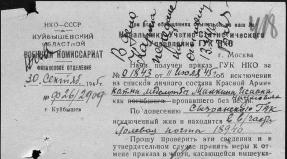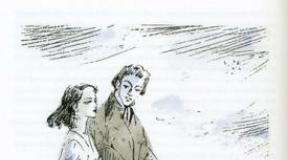The technique of conducting psychotherapy in the treatment of alcoholism. Family psychotherapy. The program of game correction of developmental disorders of the properties of the subject of self-awareness and communication in socially and pedagogically neglected children
The third method of psychotherapeutic work is family psychotherapy (FP). In the work of T.G. Rybakova, the main tasks and methods of family psychotherapy were formulated, which are determined primarily by the characteristics of interpersonal relationships that develop in families of alcoholics (Lebedev, 1974). Family psychotherapy is aimed at shaping the patient's wife * of the correct attitude to the disease and treatment of her husband, weakening her neurotic symptoms that arise during the period of alcoholization of her husband, changing the system of family interaction and creating a favorable socio-psychological climate in the family. In addition, the impact on family relationships acts as one of the ways in which many other tasks of psychotherapy are solved: the formation and strengthening of the sobriety attitude, correction of emotional disorders, self-esteem, etc.
An independent task of family psychotherapy for alcoholism is the analysis and destruction of pathological manipulative relationships of patients with their wives, children and other relatives. A kind of "exposure" of the manipulations of patients, often reaching aggressive and auto-aggressive actions, is a painful but necessary stage in family psychotherapy for alcoholism, which opens up the possibility of creating more trusting, psychologically intimate relationships in the family.
Among the methods of family psychotherapy, in the process of which the main problems of family relationships are resolved, in the first place is the psychotherapy of a married couple, carried out in the triad "psychotherapist - patient - patient's wife". However, at the final stage of inpatient treatment and during the period of supportive psychotherapy, group psychotherapy for married couples becomes extremely important, which, along with psychotherapeutic effects, uses the possibilities of club work with patients. The participation of alcoholic patients in this type of treatment significantly increases the duration of remission.
In family psychotherapy of alcoholic patients, it should be borne in mind that the wife (or husband) of a person suffering from alcoholism is, as a rule, the most subtle diagnostician of the dynamics of craving for alcohol. The data obtained in the diploma work of A. Yu. Dmitrieva showed that the wives of the patients have their own "scale" of the intensity of attraction and can fairly accurately predict the approach of relapse. This should be used in the treatment process, involving wives in the analysis of motives associated with alcohol cravings in patients.
However, one should beware that the wife does not become the undisputed leader, patron, guardian, family doctor. This, in turn, can lead to an inversion of roles in the family, to the attribution of responsibility to the wife for the patient's life and his behavior, to the growth of his externality and the formation of pathologically dependent relationships. Unfortunately, many women, masculine in character, willingly go for it, having a pronounced will to power and leadership in the family. Therefore, the psychotherapist should contribute to the creation of a psychotherapeutic environment in the family without disturbing the role balance.
The psychotherapeutic function is the main one for the family of an alcoholic patient, especially in the first months. However, this does not mean the creation of special privileges for the patient. On the contrary, from a psychotherapeutic point of view, it is important to impose on the patient responsibility, adequate to the role of men in the family. Along with this, of course, emotional support, response, catharsis, sometimes suggestion and almost always training of behavior in a non-alcoholic lifestyle are needed. Thus, the tasks of the family of an alcoholic patient have the character of psychotherapy, in which spouses should be helped to orient themselves practically.
* In the context of the problems of family psychotherapy, as a rule, work with the families of alcoholic men is meant. The experience of working with the families of women with alcoholism is still insufficient, since in most cases they disintegrate even before the patients are admitted for treatment.
Various forms of psychotherapy (individual, group, family, auto-training, etc.) are successfully used at all stages of the development of alcoholism, while in most of them this type of rehabilitation treatment is an important component. He, in particular, along with sociotherapy, has a decisive place in the stabilization of remission. Therefore, improving the organization and methods of psychotherapy for alcoholism is one of the urgent tasks of clinical narcology.
Regarding the history of the problem, it can be noted that psychotherapy of alcoholism in our country has gone from symptom-centered (developing aversion to alcohol) to noso-centered, in which the main attention was paid to alcoholic illness and overcoming alcoholic anosognosia. The next stage in the development of psychotherapy for alcoholism was the formulation of the tasks of personality-oriented (reconstructive) psychotherapy, based on the concept of relations by V.N.Myasishchev. As studies have shown, in alcoholism, there is a violation of the system of significant personal relationships, primarily the relationship to oneself, the hierarchy of relationships is distorted. These disorders can precede illness and contribute to the development of alcohol dependence. However, in most cases, they are a consequence of the disease and can prevent the formation of a stable remission. Therefore, the study of the patient relationship system continues to be important for the improvement of psychotherapeutic approaches, since the implementation of the main task of alcoholism psychotherapy - the development of a mindset for sobriety - is carried out on the basis of reconstruction of the patient's relationship.
Another important area in need of correction in patients with alcoholism is motivational-need. Based on the results of the study of the pathological craving for alcohol, the motivation for turning to alcohol, the content of the motivation for alcohol abuse is the unrealized needs of the individual, objectified in alcohol and the rituals of its consumption, and its internal plans and development programs. The psychotherapeutic effect with this approach involves the correction of unconscious motives and actions of patients, which are based on the attraction to alcohol and the analysis of alternative possibilities of the individual to maintain sobriety.
The main mechanism of psychotherapeutic correction of personality disorders in alcoholism, as in other diseases, is the expansion of the sphere of self-awareness. But according to modern concepts, it is the violations in the sphere of self-awareness, the highest level of which is the emotional-value attitude towards oneself, and many aspects of which are closely related to the affective sphere, volitional self-regulation and psychological protection of the individual, are considered as one of the causes of alcohol abuse. Compensation for these violations, as well as the formation of an attitude of sobriety, is achieved due to the intrinsic relationship of the individual. The formation of an adequate self-esteem, an increase in the self-esteem of patients with this approach is promoted to the center of psychotherapeutic tasks.
With the concept of relationship V.N. Myasishchev is closely related to the concept of personal meaning. Personal meaning is a special level of individual consciousness, reflecting the emotional-value attitude towards the world, inextricably linked with the motivation and general orientation of the individual. The form of manifestation of personal meaning can be the emotional coloring of an object, unconscious attitudes and readiness. The study of the individual personal meaning of alcohol consumption in relation to the tasks of psychotherapy opens the way for the diagnosis of disorders in the sphere of self-consciousness in patients with alcoholism and possible tasks of psychological correction. Separate studies of the peculiarities of the semantic structure of the personality in alcoholism indicate that patients with alcoholism are characterized by a simplified, folded structure of the semantic regulation of life, the dominance of near motives with a reduction in the distant perspective, and planning for the future. The main direction of the semantic regulation is protective, allowing to avoid discomfort in situations of deviation from social stereotypes, which is provided by the protective mechanism of denial. In-depth studies of the motivational and semantic sphere of alcoholic patients in the process of psychotherapy can contribute to the clarification of psychotherapeutic tasks and the development of new methodological approaches aimed at correcting disorders of self-awareness and integrating the variety of psychological influences on the patient.
An important factor in improving the psychotherapy of patients with alcoholism may be the individualization of psychotherapeutic programs depending on the clinical-psychological and socio-psychological characteristics of patients. It is known how important the attitude of a person to illness, understanding and recognition by the patient of his illness as alcoholism, is for the formation of an attitude of sobriety. For the differentiation of psychotherapeutic tasks and the development of individualized approaches, it seems appropriate to use research data on the types of attitudes towards the disease of patients. The type of attitude towards the disease can change in the course of psychotherapy and therefore its change as a result of treatment can be used to predict remission and assess the effectiveness of treatment. Revealing such a connection can also contribute to the development of special interventions in order to harmonize the patient's attitude to his disease and increase the effectiveness of psychotherapy.
The main difficulties in psychotherapeutic work are alcoholic anosognosia, which reflects a special attitude towards one's disease associated with its denial. The very structure of alcoholic anosognosia is still insufficiently developed. Some authors consider alcoholic anosognosia a manifestation of a psychoorganic syndrome that develops in the dynamics of alcoholic illness, while others associate it with affective disorders and depersonalization, the degree of alcoholic personality changes. The point of view is expressed that the balance of noso-anosognosia is determined by both social factors and the stage of the disease, as well as premorbid personality traits, including intellectual resources. Some authors draw attention to the fact that the clinical manifestations of anosognosia are based on an unconsciously or consciously existing craving for alcohol. Most authors consider alcoholic anosognosia as a result of the action of psychological defense mechanisms in relation to the awareness of traumatic information about alcohol dependence.
In order to increase the effectiveness of psychotherapy, it seems appropriate to clarify the structure of anosognosia and to consider in more detail the action of the mechanisms of psychological defense in the process of forming an attitude towards the disease, as well as their influence on stabilizing remission. Consideration of alcoholic anosognosia from the standpoint of the systemic-personal approach and the identification of types of anosognosia depending on the leading factor involved in its formation (cognitive, emotional-personal, socio-psychological) can contribute to understanding both the need to integrate psychotherapeutic approaches and modification and individualization of the tasks of psychotherapy for its correction.
It is known that during psychotherapeutic influence a number of difficulties arise, associated both with taking into account the mechanism of psychological defense chosen by the patient, and with overcoming resistance, which arises not with protection from internal stress, but from external, associated with the perception of the doctor as a bearer of a threat. It manifests itself in different ways and is often expressed in the fact that simple informing for the purpose of “retraining” turns out to be ineffective. At the same time, it turns out that it is practically impossible to change the patient's system of attitudes by directive methods and instructions, some of the advice is misunderstood, and excessive intimidation with the possibility of the consequences of alcoholism does not cause a desire to be treated.
In group psychotherapy, resistance can be manifested in a significant dropout after the first sessions (from 30-50% according to V. N. Nikolaenko), in refusal to perform those exercises that are recommended by the psychotherapist. The importance of studying the patient's protective behavior is emphasized by the fact that there is evidence of the possibility of using the same defense mechanisms that the patient used to justify his drinking, to achieve sobriety. Adequate restructuring of psychological defense that deserves serious attention can be carried out only after 2-5 years of abstinence from alcohol.
In the light of the above, the need for not only short-term, but also longer-term long-term psychotherapy is obvious, the conduct of which, as experience shows, depends on the patient's attitude to these types of treatment. There are indications in the literature that the patient's propensity for psychotherapy is significantly associated with his active (adequate) behavior during psychotherapy and better treatment results. According to N. Rudestam, this factor (activity - passivity of the patient during psychotherapy) can more accurately predict the results of treatment than using personal characteristics. At the same time, there are only a few works concerning the assessment of various components of treatment by patients with alcoholism, although almost all narcologists share the point of view about the importance of taking into account the patient's attitude to the therapeutic process. Some of the authors, who take extreme positions on this issue, work only with patients who are focused on receiving treatment, neglecting the formation of motivation for treatment in a hesitant or negatively-minded patient. Other authors consider it reasonable to refuse any additional, in addition to the initial, medical assistance to the patient, so as not to cultivate the patient's passive role in achieving sobriety. It is obvious that the patient's acceptance of responsibility for the outcome of treatment and the nature of his role in this process are important components that affect the effectiveness of anti-alcohol treatment. However, they usually fall out of sight in the design and therapeutic programs. Therefore, it seems appropriate when developing the issues of improving anti-relapse treatment and, in particular, psychotherapy, to take into account the nature of the attitude of patients to various types of anti-alcohol treatment. For the purposeful use of these variables, it is advisable to study them in heterogeneous patient populations. As our studies have shown, the complex of psychotherapeutic tasks to strengthen the stability of remission and the success of the socio-psychological readaptation of patients should include the tasks of timely recognition and impact on the symptoms preceding a relapse (decreased cognitive vigilance, actualization of craving for alcohol, affective and psychogenic disorders, etc.) .), as well as overcoming psychological and socio-psychological conflicts inherent in patients with alcoholism in remission. Successful prevention of the main causes of relapse is possible in the process of family psychotherapy, therefore, the development and improvement of methods of family psychotherapy for alcoholism is so urgent. The family acquires special significance when cognitive-behavioral approaches are used to identify the pathological craving for alcohol by the patient's relatives. Since attraction is the deepest level of motivation, i.e. the initial stage of the motivational process, it is often characterized by a lack of awareness, which creates certain difficulties in addressing issues of relapse prevention. The family is usually the first indicator of the actualization of the alcohol craving in the patient and the stabilizer of his self-esteem. At the same time, neuroticization of the wife, exacerbation of role, sexual and other family conflicts during remission significantly complicates the identification of the husband's condition for wives and may contribute to his alcoholization. Therefore, the identification of certain patterns in the assessment by wives of the behavioral referents of the pathological craving for alcohol in patients in remission can contribute to the specification and individualization of the tasks of family psychotherapy.
In connection with the increase in the share of young people among those who applied for treatment, noted in recent years, the study of the characteristics of relationships in the parental family of young alcoholics is of particular importance. In modern family research, the focus of attention is shifting from the study of diode relationships (alcoholics and their wives, alcoholic parents and their children) to the study of the family system as a whole and the structure of family ties. From the standpoint of a systematic approach, alcohol consumption by a person always has a semantic, adaptive, homeostatic character. Alcoholism is not only a consequence of alcohol abuse as such, but the result of profound changes in dynamics in the "family system". High tension, conflict, and sometimes the breakdown of the family occurs as a result of a violation of communication. Usually, one of the most important parts falls out of the sphere of communication - the communication of the subject with people equal to him, as a result of this, forms of communication of the "parent-child" type remain, which leads to increased conflict in the parental family.
Another feature characteristic of alcoholics in family relationships is manipulative behavior. The object of manipulation is, as a rule, the fears and fears of relatives about the possible consequences of the patient's drunkenness. Therefore, the analysis of the interpersonal behavior of young alcoholic patients may be of practical importance for the purposes of psychotherapy. Identification of the types of relationships in families where children are sick with alcoholism may be the basis for a targeted psychological correction of disturbed relationships and stabilization of remission.
One of the possible directions for improving the methods of psychotherapy for alcoholism may be the modification of already approved methods in order to increase the efficiency of their use. In domestic narcology, methods of mental self-regulation are widely used: the classic version of auto-training and its numerous modifications, which are based on the principle of verbal self-regulation of the emotional state. On the basis of autogenous training, methods have been developed for developing aversion to alcohol with an exacerbation of craving for it. Within the framework of the concept of behavioral psychotherapy, a program for training behavioral skills in a state of "autogenous immersion" has been developed for patients with alcoholism in remission. It is based on identifying situations preceding alcoholization (drinking) and teaching the patient alternative forms of behavior in these situations, which helps prevent “breakdown”. However, the effectiveness of all these methods is limited, since they all involve the patient's active participation in their development, which is often problematic due to alcoholic changes in the patient's personality (passivity, weak-willedness, focus on obtaining a quick result, etc.). Hence, the need for the development and modification of methods is obvious to overcome the opposition of patients to involvement in the therapeutic process by using techniques that help the patient in a faster and more effective mastery of the skills of self-regulation of the mental state.
The effective use of psychotherapeutic methods in anti-relapse treatment sets the task of improving and organizational forms in which their application is possible. Long-term experience of conducting supportive and family psychotherapy in the department of alcoholism treatment of the Institute. V.M.Bekhtereva showed that for the organization of psychotherapeutic and socio-therapeutic care for patients with alcoholism in remission, new forms of medical and organizational work are needed, combining the tasks of inpatient and outpatient care, allowing after inpatient treatment to preserve the collectives of psychotherapeutic groups for long-term psychotherapy, to ensure unity psychotherapeutic tactics and continuity in solving psychotherapeutic problems. Long-term psychotherapy of patients in remission at the inpatient department of the narcological department creates favorable conditions for the readaptation of patients to a sober life, as well as for early relief of developing breakdowns or relapses, allows, if necessary, to carry out immediate hospitalization of the patient to the hospital. The opinion about the justification in a number of cases of hospitalization of patients to prevent relapse has existed for a long time. However, earlier the practice of inpatient maintenance therapy of alcoholic patients in remission was often limited to the fact that, regardless of the clinical condition, at certain intervals (6-8 months), patients were hospitalized to check the course of general strengthening sensitizing treatment. Short-term (10-12 days) hospitalization of patients was also practiced when it was impossible for the outpatient clinic to stop their exacerbated craving for alcohol.
Recently, an opinion has been expressed about the need for a narcological hospital to provide outpatient care for previously treated patients. Sharing this point of view, we believe that an inpatient narcological department should provide such assistance not only to patients with long-term remissions who are part of the therapeutic community (a club of former patients, groups of supportive and family psychotherapy) and patients with a real threat of relapse associated primarily with intensification of affective, neurasthenic-like disorders and actualization of craving for alcohol, but also for patients discharged after treatment with insufficient compensation for the main biological and socio-psychological manifestations of the disease. Therapeutic measures carried out in such a department determine its rehabilitation orientation and complement the existing inpatient and outpatient services for drug addicts, partly combining their functions, which makes it possible to increase the effectiveness of treatment.
The data presented here, it seems to us, with sufficient convincing evidence of the need to take into account, when developing new and improving existing methods of psychotherapy, designed to maximize stabilization of remission and prevention of relapse, a number of psychological and social factors involved in the pathogenesis of alcoholism. Such factors are the patient's attitude system, the motivation for turning to alcohol and the motivational sphere in general, the sphere of self-awareness, the phenomenon of psychological defense, the change in these factors during treatment (if such a change occurs), the psychological picture preceding the next relapse of the disease. A particularly important set of data that must be taken into account in this case is the structure of the patient's family relations and the place occupied by alcohol problems in them. Undoubtedly, an important role is played in this case and organizational aspects that make it easier to implement the proposed measures in practice.
In medicine, there is such a thing as etiotropic treatment. It differs from symptomatic and pathogenetic by eliminating not the signs (symptoms) of the disease or pathological processes occurring in the body, but the cause. For example, in infections, the etiotropic measure of treatment is antibiotic therapy... Antibiotics kill bacteria that cause disease. Antipyretic, pain relievers are symptomatic drugs, because they only improve the condition, but do not affect the cause.
Every doctor always seeks to prescribe etiotropic treatment, even if the cause of the disease is not fully established. This principle is adhered to in alcoholism. It is the rehabilitation of alcoholics that should be considered a measure aimed at causal factors. It is she who helps to cope with the disease completely.
The most common misconception is that coding completely cures alcoholism. In fact, it is only a prohibitive measure. The patient is forced to refrain from drinking alcohol, but the dependence persists. An alcoholic can never drink "culturally". Even a small dose of alcohol is likely to result in another binge. This is a consequence of pathological changes in the body.
A complete cure for alcoholism is a complete rejection of alcohol. This is possible only if psychological dependence is eliminated. A person must learn to cope with conflicts and problems without a dose. Rehabilitation centers for alcoholics are dealing with these issues. Psychologists work with patients here.
Common schemes of rehabilitation treatment for alcoholism
Method "12 steps"
The "12 steps" scheme for alcoholism is considered one of the most effective and is practiced by most modern rehabilitation centers and in "groups of alcoholics anonymous". During the course, the patient consistently gets rid of old pathological attitudes and develops new ones aimed at a sober lifestyle.Method history
At the end of the 18th century, a group of theologians decided to create a technique that would help people with alcohol addiction get rid of their addiction. On this basis, groups of "Alcoholics Anonymous" began to gather. The step-by-step scheme of quitting alcohol, combined with group work, gave very good results.
Initially, the scheme was ten-step. In 1935, it was reimagined and supplemented by two American addicts in the past. They formed a group that quickly grew and gained followers around the world. Subsequently, the "12 steps" scheme was recognized by many experts as one of the most effective.
Rehabilitation program "12 steps"
| Step # 1 | “We are not able to cope with our alcohol dependence on our own. We are unable to control ourselves and fully admit it. " The biggest misconception of an alcoholic and any drug addict is that he is in control of the situation, that he "can quit at any time." Such self-confidence does not allow to objectively assess the situation and understand how serious the problem is. In order to effectively fight a disease, a person must first recognize it and face it. |
| Step # 2 | “We need outside help. Only someone who is smarter and stronger than us can help us get rid of our addiction. " This is a logical conclusion following from the first step. A person cannot control his life, but he would very much like to change it. This means that he needs the help of someone who is capable of this. The first step is recognizing that the alcohol addiction is stronger than the person's personality. This is a dead end. But at the second step, the exit becomes visible. |
| Step # 3 | “We decided to entrust the situation to God or what we mean by this word. We understand that only the most powerful force in the Universe can help us. " Initially, the methodology was developed by Christian theologians. But in the modern modification, the patient can understand anything by the word "God". For some it will be a deity from some kind of religion, for some it will be the Universe, for some it will be some kind of abstract personality of their own. The main thing is for a person to imagine some kind of powerful force and entrust it with custody of himself. This helps to transform the intention correctly. |
| Step # 4 | "We objectively and without fear investigated ourselves, everything that is inside us". This step is very important so that a person can adequately, from a new position, evaluate his thoughts and actions. Now that he has trusted in a higher power, he has a certain starting point, a certain standard. There is a shift from the human ego to the super-ego of God. We can say that this is a look at oneself from the outside, but not from the position of another person, but from the position of someone more moral, wise, objective. |
| Step # 5 | "We fully recognize the reasons for our erroneous thoughts and actions in front of ourselves, other people and God." The work begins with a sense of guilt, which will then be used to transform the patient. This step is often referred to as the “blackening of the self” stage. A person understands that he thought and acted incorrectly, erroneously, viciously. He transfers his guilt outside, tries to figure out why it happened exactly like this, what are the true reasons. |
| Step 6 | "We are ready for God to free us from the vices that we now have". This step is very important as it prepares the alcoholic for change. The effectiveness of the transformation depends on how well the preparation is carried out. Asserting his readiness, the patient thereby expresses a desire to change, speaks about it publicly. |
| Step 7 | "We humbly ask God to change us, to get rid of our shortcomings.". This step is called "whitening self". It is impossible for a person to keep a feeling of guilt in himself for a very long time. After all, it is one of the reasons that support alcohol addiction. The accumulated energy should already be directed towards the transformation of the personality. The patient's personality must change. Only he and his God know what these changes should be. |
| Step # 8 | “We have compiled a complete list of all people who, to one degree or another, have suffered from our actions. Now we have a desire to compensate for all the damage caused. " "Whitening I" continues. All members of the group should make lists of real persons whom they have harmed, and there should be a desire to make amends. Outward “corrective” action is a powerful tool for resolving external and internal conflicts. |
| Step 9 | "We have completely compensated for the harm that we caused to other people, as much as we could do it." Awareness of one's guilt and the desire to make amends is a certain energy. If she does not find an appropriate outlet, then aggression arises, which can lead to relapses. Therefore, the intention should be backed up with appropriate action as soon as possible. |
| Step 10 | “We continue to engage in introspection even now. We try to immediately notice all the mistakes we make. " Then the patient acts according to the already worked out scheme. Any negative, “wrong” act must be noticed and realized immediately. The resulting aggression is directed in the right direction - to make amends. There must be constant work on oneself: it prevents the accumulation of negativity inside, which could cause a new relapse. |
| Step 11 | “We pray and meditate often and in large quantities. We are trying to establish even closer contact with our God, or what we mean by him, in order to understand His will, our purpose in life. " When the feeling of guilt is defeated, it is necessary to continue self-improvement and look for new meaning in life. After all, before the constant use of alcohol was everything for a person. Without it, a large void is formed. It must be filled with something. |
| Step 12 | “We completed all the steps of this program and achieved spiritual awakening, got rid of our addiction. Now we are ready to live in a new way and carry the good news to all who are still addicted to alcohol. " Man has learned to live without addiction. Now he knows how to control his thoughts and actions. The foundations have been laid for a profound transformation of the entire way of life. Now he may well find his place in society, in the future there will be positive changes in communication with people around him. Trying to help other alcoholics who have not yet got rid of addiction, a person thereby increases his own motivation for a healthy lifestyle. |
Rehabilitation scheme
When using the 12-step method for alcoholism, group meetings usually take place once a week for 12 weeks (sometimes it takes 15 weeks). The first introductory lesson lasts 1.5 hours, then - 1 hour.
During the sessions, the active participation of each patient is expected. A psychologist or psychotherapist only initiates, directs. The transformation of the personality of the alcoholic is carried out by him. If he has a negative attitude towards treatment and is not ready to work on himself, then most likely the effect will not be achieved.
Treatment of alcoholism by the Shichko method
 History and essence of the method
History and essence of the method
Gennady Andreevich Shichko - Soviet candidate of biological sciences. He worked for a long time at the Institute of Experimental Medicine of the Ministry of Health of the RSFSR.
Shichko developed his method from 1950 to 1980. This is not just rehabilitation, but a full-fledged course of treatment that replaces coding. Gennady Andreevich suggested abandoning medication and various types of suggestion. His methodology is based on the postulate that every person is programmed for sobriety from birth. But during life there is a "reprogramming" under the influence of society. Thus, the state of alcoholic intoxication is abnormal, unnatural.
Scheme of treatment and rehabilitation according to the Shichko method
Conditions for effective treatment:
- The patient must admit that he is sick and needs treatment. According to Shichko, any systematic use of alcoholic beverages is a pathology, since a sober lifestyle is inherent in a person by nature. If the patient does not want to admit that he is sick, then it makes no sense to start treatment.
- A person should be ready to cooperate with a doctor, to be treated, to take active steps to recover.
Shichko alcoholism treatment program:
 Photo PhotoBefore starting treatment, the patient must take a photo and carry it with him at all times, or hang it at home in a conspicuous place. In the future, photographs must be taken on the 10th, 30th and 100th days from the start of treatment. The face of an alcoholic always takes on a specific appearance. After giving up alcohol, it gradually changes for the better. The person compares the photo, sees it, and his motivation increases. |
 Alcoholic autobiography Alcoholic autobiographyThe patient should write a detailed biography in which he talks about his life, starting from the moment he first tried alcohol. You need to honestly and frankly talk about everything:
|
 Keeping a diary Keeping a diaryThe alcoholic should keep a personal diary from the first days of treatment. You need to write in it:
|
 Testing your own suggestibility Testing your own suggestibilityThis can be done independently or under the guidance of a psychotherapist. The patient must understand to what extent he is able to suggest something to himself. Checking method:
|
 Creating a sober mindset Creating a sober mindsetDepending on the test results, the patient writes a text under the guidance of a doctor, in which he carries out self-action:
|
 Consolidation of results Consolidation of resultsWorking on oneself and leading a sober life is a difficult task for an alcoholic, especially at first. Motivation is often lacking. Any problem that arises can upset the inner balance and lead to relapse. As soon as a positive result is achieved, it must be immediately consolidated. Fixing methods:
|
 Finding a life purpose Finding a life purposeWhen people who quit smoking, but could not resist, are asked why they returned to the addiction, the answer often follows: "when there was nothing to do, I decided to go to smoke." The situation with alcoholism and domestic drunkenness is similar. If a person does not have an occupation in life, work or at least a hobby, then the risk of relapse is always high. When the patient realizes that he is returning to a normal lifestyle, he must find an interesting job for himself. It is desirable that relatives help with this. |
How effective is Shichko's technique?
Shichko's method has an effect on many alcoholic patients, especially in the early stages. Due to the refusal to use medications and physiotherapeutic procedures, the technique is safe and has no contraindications or side effects.
The disadvantage is that treatment and rehabilitation according to Shichko act mainly on suggestible people. Patients with a low degree of suggestion often have to resort to drug coding.
Group psychotherapy for alcoholism
 History of origin
History of originAt the beginning of the 20th century, nurses in US clinics noted that group sessions with patients are always much more effective than with one person. For example, if you give a lecture on hygiene measures to several patients, everyone begins to follow the prescribed procedures, motivating and supporting each other.
In 1931, American physician Jacob Moreno took this principle as a basis and began to create groups of patients to deal with psychological problems. The first issue of the magazine "Group Psychotherapy" was published under his editorship. Later, these techniques were used in the rehabilitation of patients with alcohol and drug addiction.
Description of the method
Typically, group psychotherapy for patients with alcohol dependence includes 7-10 sessions. The duration of each of them is up to 1.5 hours.
Types of groups for alcoholism rehabilitation:
- Skill trainings... Organized only by professional psychologists or psychotherapists in a specialized clinic, office. Participants must complete tasks given by a specialist. The psychotherapist plays a leading role during the training.
- Encounters... It is assumed that there is a leader, most often a psychologist, but the main role belongs to the participants. They share their stories, communicate, motivate and support each other.
- Look at yourself from the side, through the eyes of others.
- Get answers to your questions.
- Stop denying your addiction, recognize the presence of the disease and understand that it needs to be dealt with.
- Get the information you need.
- Speak up, express your feelings and thoughts, get support from like-minded people.
- Master the skills of effective communication in society.
- Learn to cope with stress and conflict situations, manage your emotions.
- Realize and accept responsibility for his future life.
Family psychotherapy for alcoholism
 Method history
Method historyFamily psychotherapy is one of the youngest psychotherapeutic practices. It began to be used after the 50s of the last century. Soon, many drug treatment clinics became interested in the method. In Russia, family psychotherapy began to be widely practiced closer in the mid-90s.
Method description
The people around the patient have a strong influence on him. Therefore, working with the whole family is a logical continuation of working with the alcoholic himself - after all, this is the micro-society to which he will eventually return after treatment.
Practice shows that relationships in such families are almost always far from ideal. Usually, psychotherapists and psychologists invite parents, brothers and sisters, children of the addict to the sessions.
Goals of Family Psychotherapy for Alcohol Addiction:
- Teach family members to communicate, express their emotions, thoughts, claims to relatives. This is usually the biggest problem in alcoholic families.
- Introduce new rules of sobriety in the family. The environment should not provoke a person to drink alcohol.
- Establish a trusting, warm, benevolent relationship between all members of the family.
- close people do not recognize the merits and merits of the patient;
- he is often reproached with low social status, insufficient income;
- general unfavorable situation in the family: relatives are “closed” from each other, an atmosphere of innuendo, resentment, irritation constantly reigns;
- the desire of relatives to constantly patronize the alcoholic.
Treatment and rehabilitation for codependency
 Codependency- This is the dependence of the behavior and way of thinking of relatives on the alcoholic. Close people, in an effort to save the patient from addiction, begin to take care of him in every possible way, but in the end they themselves become dependent on his condition. Their actions begin to be excessive. It may seem that they subconsciously like to take care of the patient, they can no longer imagine their life without his dependence.
Codependency- This is the dependence of the behavior and way of thinking of relatives on the alcoholic. Close people, in an effort to save the patient from addiction, begin to take care of him in every possible way, but in the end they themselves become dependent on his condition. Their actions begin to be excessive. It may seem that they subconsciously like to take care of the patient, they can no longer imagine their life without his dependence. Signs of codependency:
- Attitude towards a drinking relative is manifested in the form of strong, over-expressed emotions: resentment, anger, feelings of hopelessness.
- Relatives constantly hope for a "miraculous recovery" and expect the disease to go away on its own.
- The whole meaning of a codependent person's life is to constantly help an alcoholic.
- The codependent loses the ability to adequately assess the situation. He tries to surround the patient with even more attention and care, but they have destructive consequences.
After the patient has undergone treatment and got rid of the addiction, the codependents also require rehabilitation. It is carried out as part of family psychotherapy.
The use of medications during rehabilitation for alcoholism
Medications that can be used during alcohol rehabilitation:| A drug | Description | Mode of application |
| Complex vitamin preparations | Vitamins are biologically active substances that improve metabolic processes. During the rehabilitation period, they are especially important for the weakened body of the alcoholic. The doctor usually prescribes complex preparations containing the entire range of vitamins and minerals.
| Modern multivitamin preparations are ready-made pills, in which each vitamin is contained in the required dosage. You can buy them at any pharmacy. Some vitamins (B1, B6) can be given in the form of intramuscular injections. |
| Piracetam | Nootropic drug, improves metabolism and function of brain cells. Restores normal thinking, attention, memory. | Piracetam is taken for a month or more. Application scheme:
|
| Vinpocetine (Cavinton) | Effects:
| Cavinton is available in the form of tablets (0.005 g each) and a solution in ampoules for intravenous injection (0.5% - 2 ml). Application in tablets: 1 - 2 tablets 3 times a day as directed by your doctor. In injections, Vinpocetine is not used for routine treatment. |
| Nicotinic acid (vitaminPP) | The drug dilates the small vessels of the upper half of the body, improving blood circulation in the brain. | It is produced in the form of a solution in ampoules for injection. One injection is given intramuscularly daily. The course lasts 10 days. |
| Glycine | Glycine is an amino acid. Effects:
| Available in the form of tablets of 0.1 g. Take one tablet under the tongue 2 - 4 times a day. |
Adaptogens:
| Adaptogens are preparations, as a rule, of herbal origin. They mobilize the internal resources of the body, increase tone, enhance immunity, and help to better tolerate negative external influences. | Adaptogens are available in the form of capsules, tinctures, syrups for oral administration. The specific drug and dosage are selected by the attending physician. |
Taking medications should be carried out only as directed and under the supervision of a physician. Self-medication can lead to negative consequences.
Other rehabilitation methods for alcohol addiction
Zhdanov's technique
 Vladimir Georgievich Zhdanov is a public figure and activist with no medical education. Since the 80s, he has been an ardent fighter against alcoholism and smoking, and has been promoting non-drug methods of treatment and rehabilitation. It relies on the Shichko method, but adheres to more radical positions. Forbids his followers to consume any products prepared by the fermentation method, as they contain small amounts of ethyl alcohol.
Vladimir Georgievich Zhdanov is a public figure and activist with no medical education. Since the 80s, he has been an ardent fighter against alcoholism and smoking, and has been promoting non-drug methods of treatment and rehabilitation. It relies on the Shichko method, but adheres to more radical positions. Forbids his followers to consume any products prepared by the fermentation method, as they contain small amounts of ethyl alcohol. Rehabilitation of alcoholics in a monastery
It has long been common in religious circles. The patient, after detoxification and coding, is voluntarily placed in the monastery environment for a long time. Spiritual self-improvement certainly leads to getting rid of passions, including alcoholism.Acupuncture
Acupuncture is actively used at the stage of rehabilitation for alcohol addiction. It helps to fight psychological problems and restore inner balance.Despite the fact that 95% of people consume alcohol throughout their lives, there is no precise data that would adequately determine the number of alcohol abusers or addicts. The recorded incidence rate of alcoholism in the Russian Federation in 2006 was 1618.73 per 100 thousand of the population.
This pathology is most common at a young age (15-30 years), in people who are divorced or single, with a lower level of education and antisocial tendencies in adolescence. Alcohol problems are more common for men than for women (2-3: 1). In women, alcohol abuse occurs at a later age with rare spontaneous remissions.
Alcohol abuse plays a significant role in misconduct and suicide. On average, the life expectancy of patients is shortened by 10 years in comparison with healthy ones. In times of crisis, the number of people using psychoactive substances is increasing. Therefore, in the current socio-economic conditions, an increase in the number of alcoholic patients should be expected, which makes the topic of psychotherapy of alcoholism extremely relevant. It can be considered as an element of the anti-crisis health care program in Ukraine.
Alcohol dependence is the result of a complex interaction between the biological vulnerability of the body and the influence of environmental factors. Biochemical disorders play a significant role in the pathogenesis of alcoholism. A number of alcohol metabolites affect certain systems and structures of the brain. There are changes in the neurochemical adaptation of the brain at the cellular level, catecholamine neuromediation in the limbic structures, in particular in the "reinforcement system". This leads to the body's dependence on alcohol to maintain established pathological homeostasis. The key psychopathological disorder in Russian narcology is considered to be an addiction syndrome with characteristic signs of a pathological craving for alcohol.
There are two defining stages in the treatment of addiction syndrome. The first is characterized by intensive therapy of acute conditions - treatment of withdrawal symptoms and suppression of the primary pathological craving for alcohol. The second stage is anti-relapse therapy and suppression of psychopathological affective, behavioral, cognitive and somatic disorders associated with the manifestation of a secondary pathological craving for alcohol. At the second stage of alcoholism treatment, in addition to biological therapy, psychotherapy is of great importance.
Psychotherapeutic methods used in the treatment of patients with addiction to psychoactive substances are divided into three main groups, which differ in the nature of the impact: manipulative strategies, personality development, synthetic.
Methods of a manipulative nature are addressed mainly to pathological processes. The patient is considered as an object of influence, the goal is to change his behavior. Therapy is often short-lived, the result is achieved relatively quickly, but it is unstable. The relationship between the patient and the psychotherapist is characterized by patterning on the part of the physician, taking responsibility for the outcome of the treatment. These methods include suggestive and behavioral therapy.
With the methods of psychotherapy that develop the personality, the patient acts as a subject of influence, the goal is the transformation of the personality. The therapy is quite lengthy and laborious. Results are achieved relatively slowly, but more robust than using manipulative methods. The relationship between the therapist and the patient is characterized by partnership. This group of methods includes psychoanalysis, gestalt therapy, client-centered therapy according to K. Rogers and other methods of humanistic orientation.
Since the mid-70s. of the last century in the psychotherapy of patients with addiction to psychoactive substances and alcoholism, in particular, the leading role is played by family psychotherapy. The need to involve the family in the process of treatment and rehabilitation of alcoholic patients does not require special evidence. According to the concept of psychogenesis of alcoholism by S. Reichelt-Nauseef and C. Hedder, the latter is understood not only as an individual's pathology, but also as a result of interaction between all family members or as part of the functioning of the family structure aimed at maintaining family homeostasis. As the experience of working with families of alcoholic patients shows, such underlying motives of the pathological craving for alcohol as using it as a means of increasing self-esteem, compensating for any missing forms or ways of satisfying needs, "communication - communication", interpersonal protection - manipulation, are formed mainly as a result of improper family upbringing - by the type of explicit and latent emotional rejection and hypoprotection. As shown in T.G. Rybakova, the wives of alcoholics in the period of remission of the husband's alcoholism have increased neurotic symptoms. Characteristically, on an emotional level, a wife can perceive a drunken husband as a strong, extraordinary, bright person, and a sober one as boring and weak, who does not love her and does not pay any attention to her. At the verbal level, in the first case, words of condemnation are pronounced, in the second - "objective" and detached approval. Common for the wives of alcoholic patients is a tendency to emotional instability, reversible with the harmonization of family relations.
Among the methods of family psychotherapy used, several of the most common can be distinguished: individual psychotherapy with each family member; psychotherapy with individual married couples; group psychotherapy for married couples, in some cases including separately conducted group psychotherapy for husbands and wives; family participation in sobriety clubs and psychotherapy communities; psychotherapy of children with alcoholism.
Due to the complexity of relationships in families of alcoholic patients and the variety of tasks of family psychotherapy, a differentiated-complex (synthetic) approach, based on taking into account the need for therapy of each family member, seems to be the most justified. A constant component of the complex of methods of family psychotherapy for alcoholism is individual psychotherapy with each family member.
Within the psychological theories of alcoholism, there are ideas about this addiction as a form of self-destructive behavior. In other words, the psychological mechanisms of the formation and course of alcohol dependence are mediated by the individual, by the entire system of his relations. At the initial stages, alcohol often acts as a means of relieving chronic psychoemotional stress arising in connection with a violation of personal-environmental interaction and those intrapersonal conditions that impede adaptation. Within the framework of alcohol dependence, the system of values and the motivational-needs sphere of a person changes pathologically. It happens, as B.S. Bratus, "shift of motive to goal" Intrapsychic conflict arising from the systematic use of alcohol is largely resolved due to the action of psychological defense mechanisms, which makes a significant part of the information concerning him / herself unconscious for a person. Because of this, many standard questionnaires for alcoholics give distorted results. At the same time, the definition of "psychotherapeutic targets" is considered a necessary condition for successful psychotherapy.
Individual psychotherapy of alcoholic patients should be preceded by a stage of psychodiagnostics. The cognitive theory of personality - the theory of personality constructs, developed by the American psychologist J. Kelly, aims to explain how a person interprets and predicts his life experience, anticipates and constructs future events, and controls experienced events. Conducted by A.V. Trusovoy research revealed that the system of personal constructs of alcoholic patients is determined by low indicators of the intensity of internal connections, which indicates the difficulty of unambiguous predictions for this group of patients with a high degree of uncertainty in situations of social interaction; high rates of inconsistency and amorphousness, which confirms the low motivation for treatment, which is typical for addictive patients in general, the presence of a "struggle of motives", a low degree of awareness of behavior. The undifferentiated position of "I" revealed in patients with alcohol dependence, as well as the increased importance of the category of social positivity in the system of their personal constructs, characterize the action of the psychological defense mechanisms underlying anosognosia. In the process of short-term therapy in patients with alcoholism, the role of constructs related to the characteristics of an active individual lifestyle increases, the perception of their own social roles becomes clearer and more differentiated, and the overall significance of social positivity decreases. Factors of social recognition and interpersonal interaction are especially important in the personal psychosemantic space of persons with alcohol dependence, and in the process of psychotherapy, the awareness of the role of individual efforts and motivation increases, which indicates an increase in responsibility for their own life and health, as well as a change in the criteria of social perception.
Individual psychotherapy should be regarded as a necessary and permanent component of family psychotherapy for alcoholism. Individual psychotherapy makes it possible to more accurately assess the true depth of the experience of the existing conflict and the peculiarities of understanding by family members of the existing relationship. It also provides feedback from patients in group forms of psychotherapy. Individual psychotherapy allows you to achieve a certain result, but as noted by the prominent American psychiatrist, one of the founders of family therapy Karl Whitaker: “Individual therapy is a fragile thing, its achievements can be easily destroyed after graduation. it is strongly influenced by the processes of life. Changing the family system is a change in infrastructure, so it is much more sustainable; the process of change continues in the infrastructure, deeper than the level of awareness of the family or therapist. " Recovering from alcoholism rarely means the addict simply stops drinking. Addiction is a familial disorder that can be seen as a manifestation of family dysfunction. Family relationships, the most significant for a person, play a leading role in the formation of pathogenic situations and mental disorders. It follows from this that the system of assistance should provide not only the treatment of alcohol dependence in the patient himself, but also the existing disorders in other family members, denoted by the term "codependency".
In a codependent family member (usually women - wife, mother, daughter), the following manifestations of a family crisis are found: a feeling of discomfort, increased anxiety; neurotic and emotional disorders; ineffectiveness of old ways of interacting with a drinking family member; a sharp decline in the level of satisfaction with family relationships; a sense of hopelessness and futility of efforts made to change the situation; inability to find new constructive ways out of codependent relationships; hope for a miraculous healing of an alcohol-dependent family member, which has nothing to do with one's own changes; closeness (or social isolation) of the family, associated with the need to hide the problem of alcoholism; the growth of family conflicts, negative emotions and harsh criticism; destruction of family traditions.
A person with alcoholism has a strong emotional impact on the immediate family members. His behavior, his personality traits in many respects contradict the expectations of family members, their ideas about what a person should be - husband, son, brother. Therefore, the emotional reactions of loved ones to the behavior and many characteristics of the personality of a patient with alcoholism are, as a rule, indignation, resentment, irritation, anger, disappointment, despair, depression, apathy. The more the emotions of the family members of the drinking person are distorted, the less adequate help they can provide. Relationships in almost all such families are usually not helpful, but destructive. Codependency looks like a mirror image of addiction. Codependent family members use rules and relationships that keep the family dysfunctional. At its core, codependency is a destructive reaction to a traumatic situation.
The main features of the personality of a codependent include the following indicators.
1. Low self-esteem. This is the main characteristic of codependents, on which all others are based. This implies such a feature of codependents as outward orientation. Codependents are completely dependent on external assessments and relationships with other people, although they have little idea of how they should relate to them. Due to low self-esteem, codependents can constantly criticize themselves, but they cannot stand being criticized by others, in which case they become self-confident, resentful, angry. Codependents do not know how to receive compliments and praise properly, and it can even increase their feelings of guilt. At the same time, their moods deteriorate due to the lack of such a powerful fuel for their self-esteem as praise. Deep down, codependents don't see themselves as good enough, and tend to feel guilty about spending money on themselves or indulging in entertainment. They tell themselves that they cannot do anything properly for fear of making a mistake. Their minds and vocabulary are dominated by numerous “I should”, “you should”, “how should I behave with my husband?”. Codependents are ashamed of their husband's drunkenness, but they are also ashamed of themselves. Low self-esteem drives codependents when they seek to help others. Not believing that they can be loved and needed, they try to arouse the love and attention of loved ones and become indispensable in the family.
2. Compulsive desire to control the lives of others. Codependent wives, mothers, sisters of addicted patients are controlling loved ones. They believe they can control everything. The more difficult the situation at home, the more effort they put in to control it. Thinking that they can restrain the drunkenness of a loved one, control the perception of others through the impression they make, they believe that others see their family as they portray it. Codependents firmly believe that they know best in the family how things should unfold and how other members should behave. Codependents try not to let others be who they are, and also to let things flow naturally. To control others, codependents use various means - threats, persuasion, coercion, advice. They are characterized by the emphasis on the helplessness of those around them (“my husband will be lost without me”). Attempts to take control of virtually uncontrollable life events often lead to depressive disorders. The inability to achieve the goal in matters of control is viewed by codependents as their own defeat and the loss of the meaning of life. Recurring lesions make depression worse. Frustration and anger are other outcomes of controlled behavior of codependents. Fearing to lose control over the situation, codependents themselves fall under the control of events or their loved ones - patients with chemical addiction. For example, the wife of a patient with alcoholism quits her job in order to control her husband's behavior. The husband's alcoholism continues, and in fact it is the husband's alcoholism that controls her life, disposes of her time, well-being and so on.
3. The desire to take care of others, to save them. Codependents love to take care of others and often choose the profession of a nurse, educator, psychologist, and teacher. Caring for others goes beyond reasonable and normal boundaries. Corresponding behavior follows from the conviction of codependents that it is they who are responsible for the feelings, thoughts, actions of others, for their choices, desires and needs, for their well-being or lack of such in the family, and even for fate itself. Codependents take responsibility for others, while completely irresponsible in relation to their own well-being (they eat and sleep poorly, do not visit a doctor, do not satisfy their own needs). By saving the patient, codependents only contribute to the fact that he continues to use alcohol or drugs. And then the codependents get mad at him. The attempt to save the addict never succeeds. This is just a destructive form of behavior for both the addict and the codependent. The desire to save the patient is so great that the codependents do what they essentially do not want. They say "yes" when they would like to say "no", do for loved ones what they themselves can help themselves. They satisfy the needs of their loved ones when they do not ask them about it and do not even agree that codependents do it for them. Codependents give more than they receive in situations involving the drug addiction of a loved one. They speak and think for him, believe that they can control his feelings and do not ask what their loved one wants. They solve the problems of the other, and in joint activities (for example, in housekeeping) they do more than should be done according to a fair division of responsibilities. Such “care” about the patient leads him to incompetence, helplessness and inability to do what a codependent loved one eventually does for him. All this gives reason for codependents to feel constantly needed and irreplaceable. At the same time, codependency is a risk factor for relapse in a patient.
When starting family psychotherapy with the family of an alcoholic patient, one should first of all consider the model of the family system. Having identified the significant variables that make it possible to comprehend what is happening in the family, it is necessary to outline an intervention strategy. A.B. Kholmogorova proposed the following conceptual apparatus for conducting family psychotherapy.
Family structure can be thought of as topography — a quasi-spatial slice of the family system. The most important concepts that serve to describe the family structure are connection and hierarchy.
Most researchers identify symbiosis and disunity as the two main communication dysfunctions. Both symbiotic relationships and disunity characterize dysfunctional families, whose members suffer from various forms of mental pathology. The hierarchy determines the relationship of domination - submission in the family.
Microdynamics reflects the peculiarities of the functioning of the family system. For the analysis of micro-dynamics, the following concepts are introduced.
1. Family roles. A serious danger is the delegation of the role of an adult to a child, which is very typical for families with a problem of alcoholism.
2. Patterns of interaction, or communicative stereotypes arising from the roles. The style of emotional communication is characterized by the ratio of positive and negative emotions, criticism and praise addressed to each other.
3. Metacommunication, which is of great importance in the family and represents the processes of joint discussion and reflection on what is happening between loved ones.
To analyze microdynamics, a family psychotherapist must possess the following conceptual apparatus:
family history or evolution: one of the typical scenarios of the Slavic family is drinking husbands and their wives "saving";
family development cycles associated with new stages of life: Slavic families experience great difficulties in separating children due to the traditional weakness of the marital subsystem and the predominance of child-centered families;
family history traumatic events: the negative impact of traumatic experiences on the mental health of family members should be emphasized.
To analyze family ideology - the meaningful basis of family life - it is important to master the conceptual apparatus (figure). The need for family rules and regulations stems from the fact that their absence is chaos, which poses a serious danger to mental health. The vagueness of rules and norms, their lack of clarity, contribute to the growth of anxiety and confuse others. Myths include family concepts, legends, and beliefs about family history. For example, in many families dominated by women, there is a myth about the natural depravity of men. Family values are what is openly, approved and cultivated in the family circle. Traditions and rituals are repetitive, institutionalized actions that have symbolic meaning and are an important factor in reducing anxiety among family members. Families lacking traditions and rituals tend to be fragmented.
The main psychological manifestations of any addiction is a triad: obsessive-compulsive thinking when it comes to the subject of addiction (alcohol); loss of control and denial as a form of psychological defense. This statement applies to both the addict and the family as a whole. Most authors identify the following types of denial in families of alcoholics:
absolute denial: "We have no problems";
minimization: “We have small problems”;
withdrawal using refusal: "We will not talk about it";
"Resonant" withdrawal: "You need to drink culturally";
leaving with the help of a scandal: "What are you insulting?" (talking about drunkenness);
search for a "scapegoat": "I drink because of my mother-in-law, boss, etc.";
rationalization: "Drinkers do not have atherosclerosis";
intellectualization: “Who drinks? This is our culture ”;
comparison: "Here NN drinks, but he is healthy ...";
setting yourself a hopeless diagnosis: "Nothing will help me anymore";
conditioned sobriety: "I do not need treatment because I will stop drinking when I want to";
compliance: "We agree, doctor ...";
manipulations: "Do you guarantee, doctor, that he will not drink?";
democratic support for alcoholism: "Everyone does what he thinks is right."
The main goal of family therapy for alcoholism is to change family macro- and microdynamics. For a successful psychotherapeutic intervention, it is necessary to use the following stages of intervention: clinical and psychological diagnosis of alcoholism in the patient and codependent disorders in family members; individual psychotherapy aimed at overcoming the primary pathological craving for alcohol and "loosening" pathological socio-psychological stereotypes; systemic family diagnostics; family psychotherapy with overcoming protective behavior and the formation of a constructive functioning of the family.
The effectiveness of a complex of family psychotherapy techniques should be assessed using the following criteria:
acceptance of ideas of sobriety and upholding them by all family members;
normalization of family relations, overcoming conflicts and the ability to constructively solve problems arising in the family;
restoration of the role structure of the family - the optimal distribution of responsibilities for maintaining the family budget, raising children, etc .;
the family's ability to cope with relapses of the disease;
the ability to rationally use the time free from work and household chores;
family assistance to other families of alcoholics in difficult situations (assessment of the psychotherapeutic community).
Literature
1. Narcology / Per. from English - 2nd ed. Ed. L.S. Friedman, N.F. Fleming, D.G. Roberts, S.E. Hyman. - M .: SPb .: Publishing house. "BINOM" - "Nevsky Dialect", 2000. - 320 p.
2. Psychiatry: national leadership / Ed. T.B. Dmitrieva, V.N. Krasnova, N.G. Neznanov, V. Ya. Semke, A.S. Tiganova. - M .: GEOTAR-Media, 2009 .-- 1000 p.
3. Valentyk Yu.V. Modern methods of psychotherapy for patients with addiction to psychoactive substances // Lecture on Narcology. Ed. 2nd, revised and expanded / Ed. prof. N.N. Ivantsa - M .: Knowledge, 2000 .-- S. 309-340.
4. Eidemiller E., Yustickis V. Psychology and psychotherapy of the family. - SPb .: Peter, 2008 .-- 672 p.
5. Rybakova T.G. Family relations and family psychotherapy of alcoholic patients / Author's abstract. diss. ... Cand. honey. sciences. - L., 1980 .-- 23 p.
6. Brother B.S. Psychological analysis of personality changes in alcoholism. - M .: Ed. Moscow State University, 1974 .-- 110 p.
7. Francella FB, Bannister D. A new method of personality research: a guide to repertoire personal methods / Per. from English - M .: Progress, 1987 .-- 236 p.
8. Trusova A.V. Application of the technique of repertory grids in the psychodiagnostics of patients with alcohol dependence // Review of Psychiatry and Medical Psychology. V.M. Ankylosing spondylitis. - 2005. - T. 2, No. 2. - 7 p.
9. Whitaker K. Midnight Reflections of a Family Therapist / Per. from English - M .: Class, 1998 .-- 208 p.
10. Kholmogorova A.B. Family psychotherapy: history, main schools, conceptual apparatus // Modern therapy of mental disorders. - 2007. - No. 2. - 10 p.
Pathological craving for alcohol is a pivotal disorder in the aggregate of clinical and personality-psychological disorders in patients with alcoholism at all stages of the course of the disease (Bokiy I.V., Tsytsarev S.V., 1987, 1995).
Alcoholic behavior is determined by two closely related systems - biological (the effect of alcohol on the body and the formation of a drug syndrome) and social, which reveals the normative-value side of such behavior.
I. V. Bokiy and S. V. Tsytsarev (1987) proposed a classification of the leading motives and ways of satisfying needs, which determine the content side of the craving for alcohol. Craving for alcohol, including pathological, acts as a means:
1) voltage reduction;
2) changes in the affective state;
3) receiving satisfaction;
4) increasing self-esteem and self-esteem;
5) compensation;
6) communication-communication.
In addition, the attraction to alcohol acts as a result of learning and imitation, as a means of interpersonal protection - manipulation.
According to one of the most widespread concepts of alcoholism psychogenesis in foreign narcology (Reichelt-Nauseef S., Hedder S., 1985), alcoholism is understood not as an individual's pathology, but as a result of interaction between all family members or as part of the functioning of the family structure aimed at maintaining family homeostasis. According to Steinglass, alcohol consumption plays a central role in the life of a family, therefore it has a great influence on the behavior of its members when interacting (R. Steinglass, 1983).
Family members showed different emotional behavior in different situations: during the period of alcohol intoxication of the patient and during the period of his sober behavior. D. Davis and co-authors (1974) give an example of a family whose members in the first case gave the impression of people living, cheerful, prone to jokes, bright displays of emotions; in the second, they showed restraint, monotony and inexpressiveness in emotional communications. The authors concluded that alcohol abuse performs the function of regulating the emotional climate in the family - family members consciously or most often unconsciously support the consumption of alcohol by their relative.
Children and spouses of alcoholics also named the positive consequences of alcohol abuse - greater family cohesion, increased contact with parental families ("grief brings together"), attention to each other, accompanied by increased empathy and emotions (Reichelt-Nauseef S., Hedder S., 1985 ). In this regard, it becomes clear that the family factor - the conditions of improper upbringing in the parental family and the style of communication that has developed in it, as well as the nature of relationships in the married family of alcoholic patients - has a great influence on the formation and maintenance of a pathological craving for alcohol at the psychological level.
As our experience of working with families of alcoholic patients shows, such underlying motives of the pathological craving for alcohol as using it as a means of increasing self-esteem, compensating for any missing forms or ways of satisfying needs, "communication-communication", interpersonal defense-manipulation , are formed mainly as a result of improper family education - by the type of explicit and latent emotional rejection, hypoprotection (Eidemiller E.G., Kulakov S.A., 1987).
The appearance or intensification of neurotic symptoms in a part of the spouses of alcoholic patients during the period of remission confirms the stated position. It should be admitted, as did TG Rybakova (1980), that the decompensation of the wife's mental state may be due to a difficult situation associated with the husband's alcoholism. Effective treatment and rehabilitation of alcoholic patients is impossible without the use of family psychotherapy.
A clinical and psychological study of adolescents with addictive behavior (substance abuse behavior, alcoholism) using the TAT method and the Family Relationship Analysis (DIA) questionnaire showed that 60% of them blocked such important needs as emotional acceptance on the part of their parents, the need for self-affirmation and independence, the ability to establish full-fledged emotional contacts with peers, etc. (Eidemiller E.G., Kulakov S.A., 1987).
The stereotype of the role behavior of alcoholics inherent in parental families is further one of the factors that determine the dysfunctional type of relationship in their own families, which is characterized by a mismatch between verbal and non-verbal components. On an emotional level, a wife can perceive her drunken husband as a strong, unexpected, bright person, and a sober one as boring and weak, who does not love her and does not pay any attention to her; at the verbal level, in the first case, words of condemnation are pronounced, in the second - “objective” and detached approval.
Common for the wives of alcoholic patients turned out to be a tendency to emotional instability, reversible with the harmonization of family relations (Rybakova T.G., 1980).
Conflicts in families of alcoholics, in addition to the very fact of alcoholism, concerned the role structure of the family and the sphere of sexual relations between spouses. In some cases, the wives of the sick, having become accustomed to solving family problems as a result of their husband's alcoholism, did not strive, and sometimes even feared, to share responsibility for the family with their husband. In other cases, patients, who were mainly engaged in rehabilitation at the place of work, limited themselves to a minimum of responsibilities to their families, which caused dissatisfaction among their wives, who were expecting, first of all, changes in family relationships. An insoluble role conflict hindered the normalization of sexual relations between spouses (Rybakova T.G., 1986). The growing emotional stress and experience of frustrations by patients during the period of remission actualized the motives underlying the craving for alcohol, and thus a “vicious circle” was formed.
Currently, great importance is attached to psychotherapy of the whole family of an alcoholic patient (Reichelt-Nauseef S., 1985; Hedder S., 1985; Wiliez V., 1985), It is extremely difficult to implement it in practice. Many patients, due to anosognosia, refuse treatment and psychotherapy; their relatives often support the unrealistic attitudes of patients, fearing revenge and punishment from the sick for the very fact of going to a doctor. Therefore, attempts to conduct family psychotherapy even without the participation of the patient himself seem to be so relevant.
The theoretical justification for such a model of psychotherapy, which is most widespread in the United States and is still not popular enough in Western Europe, is the provision that “if everyone is interconnected with everyone, then a change in the behavior of at least one person in the system can indirectly cause changes in other people "(Reichelt-Nauseef S .; Hedder S., 1985).
The moment for such a psychotherapeutic intervention usually becomes a crisis or a pile of crises (when an alcoholic is faced with losses in his life: the departure of his wife, dismissal from work, material collapse), which almost always become a turning point in his life.
This system of psychotherapy for alcoholism seems to us very promising, so we set out it in detail.
Depending on the willingness of families to begin to deal with their problems, either “direct intervention” or “family intervention” can be offered (Wegscheider S., 1980). Direct intervention involves confrontation with an alcoholic patient with the help of family, workmates, administration, doctors, friends, and others. In family intervention, confrontation is carried out by non-alcoholic family members who are consulted by professionals such as psychotherapists, clinical psychologists and medical students.
Direct intervention. This form of psychotherapy assumes that one person from the immediate environment of a patient with alcoholism asks for help. Any crisis situation can serve as a reason for such an appeal. As a rule, it is difficult for the initiator to admit to himself and to others that there are serious problems with alcohol in the family, which the abuser himself can no longer solve. Often the initiator feels like a traitor, because he breaks the family rule - "not to wash dirty linen in public." Therefore, the request of the initiator for help is accompanied by a feeling of guilt and fear of the patient's reaction. The consultant should explain to the initiator that it is his initiative that indicates that he is acting out of feelings of sympathy and concern and is trying to bring about positive changes.
During the first counseling conversation, the psychotherapist finds out what clinical symptoms the patient has and asks about the medical, psychological and social consequences of alcoholism. If the therapist decides that the intervention is appropriate, and the initiator sees it as a chance for the family, then they make a list of all persons who are close to the patient, witnessed his alcoholic behavior and are ready to take part in the intervention. The initiator (not the consultant) contacts all of these individuals and asks for their cooperation - to establish an “intervention team”.
The psychotherapist organizes a meeting of the listed stakeholders. Informs that alcoholism is a disease and that it is denied by the alcoholic himself and his family; emphasizes that the patient at the moment can no longer stop drinking on his own and he himself will not seek help. The therapist can describe alternative options - predicting how things will go if the family does nothing, and what are the chances of a cure if people behave differently than before. He can explain his intervention and emphasize that only the willingness of those present for their own change and for confrontation with the patient at the moment can help him to go to treatment. The psychotherapist has no right to call or force the relatives and friends of the patient to intervene. Its task in this situation is to provide stakeholders with objective information and provide support. It is up to the participants in the meeting to decide whether they consider the “direct intervention” method appropriate and whether they wish to form an “intervention team”. It takes at least 8 weeks to unite this team.
Then concrete preliminary psychotherapeutic work begins with the “intervention team”, whose members learn to understand that alcoholism is currently their leading problem. At the center of work with a psychotherapist is not so much the question "how can we change an alcoholic?" ? " In the initial phase of psychotherapy, the team members see in the patient the reasons for their problems. The question of whether alcohol caused problems or whether they existed earlier cannot be answered unequivocally, therefore, clarification of this does not play a cardinal role. Crucial is the need for all participants to be able to understand what role they play in dysfunctional interactions. Often a psychotherapist at this stage of work with the family has to deal with the phenomena of psychological defense in the form of denial of the fact of alcoholization and with the problem of regulating the feeling of guilt among family members. The psychotherapist helps them express their feelings and find out what psychological losses and gains they can note in today's situation.
The psychotherapist discusses with family members the manner of their behavior that unknowingly supports alcoholism, and forces them to look for new ways to achieve this goal. He scrutinizes the intentions of each member of the Intervention Team. It is known that confrontation can be made only on the basis of positive emotions, feelings of love and sympathy for the addict to alcohol and concern for his fate. If the therapist gets the impression that the team members harbored hatred, contempt, anger or disappointment, then he should give them the opportunity to express these feelings ("discharge") in preparatory meetings. Having expressed everything that is painful, they will reveal their positive attitude towards the patient and will be able to use it constructively in confrontation. This is a very important moment in this phase of psychotherapy, because if a patient with alcoholism during the intervention feels hostility to confrontation, it will be not only ineffective, but also destructive and will lead to the fact that he becomes isolated. Only the combination of confrontation and sympathy opens up constructive access to the patient. Under the guidance of a psychotherapist, family members process their experiences, their former helplessness disappears and their willingness to take the risk of confrontation increases.
The next stage of psychotherapy is characterized by the fact that each member of the "intervention team" draws up his own list of events that he witnessed and because of which the patient, due to his alcoholic behavior, had problems. Then the participants exchange lists and discuss them. Family members are often surprised at how different these lists are. It turns out that the same events associated with the patient are perceived by them in different ways.
The psychotherapist helps everyone to formulate the incident in a direct, honest, descriptive form: on the one hand, nothing should be embellished or carelessly evaluated, on the other hand, the wording should not contain anything accusing, as this immediately forces the mechanism of psychological defense of the alcoholic patient. The wording should clearly express positive emotions, concern, and sympathy. Important events should be directly related to alcohol excess: "You drank two bottles of wine, and then went by car to your brother." The patient's behavior should be described in detail: "You staggered, almost could not speak." Generalizations, interpretations and blame should be avoided.
The statements included in the list contain:
1) an accurate description of the event and the patient's behavior;
2) attitude towards alcohol consumption;
3) expression of their own feelings about this;
4) expressing wishes or positive feelings for the alcohol addict.
It is recommended that the lists be read during the intervention. In a tense atmosphere, it is more difficult for the “intervention collective” to speak offhand than to read out their objective description. There is a danger that, with visual contact, they will feel the influence of an alcoholic patient and launch the mechanism of rationalization, which is highly undesirable. Their voices should match what they say and feel. They read their lists in a calm, honest, and friendly manner.
The next stage of psychotherapy is the choice of alternatives. Together with family members, the psychotherapist finds out what kind of decision they expect from the patient. Hospitals, self-help groups, or Alcoholics Anonymous are pre-selected so that they can be offered to the patient to choose from. The goal of the intervention is for the patient to make a decision as early as possible - preferably on the same day.
Psychotherapeutic intervention is planned by the time the patient is in a more or less pronounced crisis and his defense system is weakened (for example, when his driver's license was taken away or he received a warning at work). This increases the chances of the patient's “surrender”, that is, his consent to the course of treatment. The conversation with the patient should take place in a neutral place in the presence of a psychotherapist.
Finally, the stage of direct psychotherapeutic intervention begins. Relatives ask the patient with alcoholism to come to the consultation at the agreed time to discuss family problems. Experience has shown that the patient is often interested in where his family has been going for quite a long time and who influences it. The members of the “intervention team” read out their lists one after another and confront the patient with his reality. Thanks to this list, containing a lot of facts and read with visible sympathy, the patient's defense system breaks through - he must accept help, although he opposes it. In conclusion, those present should present the patient with a requirement that he attend a clinic or self-help group.
In 80% of all families who, after direct intervention, were offered treatment and supportive family psychotherapy, there were long periods of remission and restoration of disturbed relationships (Wegscheider S., 1983).
Family intervention. If family members are not ready or able to seek help to solve their problems, then confrontation with the help of other persons may be a chance for the family and for the alcoholic. Teachers, doctors, employees of consultations and other special institutions, workmates, representatives of the administration and the trade union should become more attentive not only to the symptoms of an alcoholic patient, but also to the condition of his relatives. The latter often complain of headaches, general malaise, inability to study at school, and depression. If the therapist sees these symptoms as a secondary problem, but the alcoholism in the family, on the contrary, is the primary problem, and if the whole family nevertheless shows resistance and denies the dependence on alcohol, then the therapist is faced with a very difficult task. He is required, as from the “intervention collective”, to collect “data” and enter into confrontation with the family as a whole or with individual family members.
During the meeting, the therapist helps establish an atmosphere of greater candor. Family members notice that they are not judged and that they should not be afraid of sanctions. The psychotherapist should explain his proposals to the family, inform her and warn her against further development of the disease, which can be foreseen if they do not want to use help.
If one family member can admit that he himself has reached the limit, and then, as a result of consultations with a psychotherapist or classes, in self-help groups, his behavior will change, then this cannot but have a positive effect on the patient. An initiator who has experienced the beneficial effects of psychotherapy can begin to work with others to prepare a direct intervention.
The proposed methods of psychotherapy - direct intervention and family intervention - are especially indicated for overcoming anosognosia of a patient with alcoholism and family psychological protection. They also contribute to the formation of treatment attitudes. And psychotherapy with individual married couples, groups of married couples and groups of wives of alcoholic patients involves the elimination of various family conflicts, the establishment of stable emotional relationships, which prevents recurrence of the disease (Rybakova T.G., 1980).
From the point of view of emotional-stressful psychotherapy (Rozhnov V.E., 1982), family psychotherapy for alcoholism is a sequential set of techniques for individual work with the patient and his immediate family, mediated and reinforced by rational and suggestive psychotherapy (Rozhnov V.E., Pavlov I, S., 1979, 1997).
Family psychotherapy for alcoholism, developed and used at the Psychoneurological Institute. VM Bekhtereva, uses the dynamics of relationships, emotional reactions that arise during interaction and discussions in a married couple, a group of married couples, a group of wives (Rybakova T.G., 1987).
Based on the study of the features of family adaptation of patients with alcoholism in remission T.G. Rybakova identified three types of families, which predetermines different tactics of family psychotherapy:
1. Families with previously benevolent relationships without disrupting the system of family interaction after resolving a conflict related to drunkenness.
2. Families with previously benevolent relationships, but with a violation of the system of family interaction due to the consequences of alcoholism.
3. Families with exacerbation of previously existing conflict relationships and disagreements on the main aspects of family life after the weakening or resolution of the alcohol conflict.
In families of the 1st type, supportive psychotherapy is aimed at strengthening the patients' attitudes towards sobriety and increasing the confidence of wives in the possibility of long-term remission in the husband. Families of the 2nd type need purposeful psychocorrectional work to eliminate conflicts caused by the consequences of alcoholism. For families of the third type, the reconstruction of the entire system of family interaction is shown to improve the psychological climate in the family.
In the presence of conflicting relationships in the family or psychopathic personality traits of the spouses at the initial stages of working with them, in order to achieve an emotional response, preference was given to individual methods of work; in the future, the psychotherapist moved on to work with a married couple. The task of the family psychotherapist was to eliminate family uncertainties that hinder the adequate role behavior of family members through the role behavior of the “benevolent commentator”.
Deepening mutual understanding between spouses, improving the emotional climate in the family created favorable conditions for the normalization of sexual relations. Group psychotherapy of married couples made it possible to teach spouses adequate ways of responding and behaving, as well as recognizing affective disorders in patients, exacerbation or emergence of pathological craving for alcohol, weakening of the patient's mindset for sobriety (Rybakova T.G., 1987).
The groups included 6-8 married couples. The main method of work is verbal discussion, which was supplemented with elements of behavioral psychotherapy: functional training of behavior according to a special program and methods of auto-suggestive psychotherapy (Goncharskaya T.V., 1979). During the first half of the year, in the presence of remission in patients, classes in the group of married couples were carried out with a frequency of 1 time per week, then 2 times a month (up to a year) and then 1 time per month. The problems of the first classes were limited to the distribution of family responsibilities and power in the family, raising children, organizing leisure time. Difficulties in adapting patients to the sobriety regimen, reports of patients and their wives about how they spend their time were discussed. Role-playing techniques helped stimulate discussion. Among the typical difficult situations that required acting out were: "meeting guests", "meeting with former drinking buddies", "returning home late." The exchange of played roles between spouses led to an increase in empathy and an understanding of the motives of each other's behavior. The cohesion of the group facilitated the transition to the discussion of the personal problems of each of its members. At the most distant stages of family psychotherapy, the elements of club work were included: the organization of joint leisure, discussion of films and books, joint vacations.
In the process of supporting family psychotherapy, a significant improvement in the psychological climate in families was observed in 89.3% of patients, and remissions lasting more than 1 year were observed in 68.3% of patients.
As an illustration of the use of methods of family diagnostics and psychotherapy in addictive behavior in adolescents, we present an observation (attending physician - S. A. Kulakov).
Patient Alexey K., 17 years old. The parents turned to the Leningrad Narcological Dispensary with a request to consult their son about the recent increase in drinking.
Heredity is burdened on the paternal side. In 1977, my father was treated at the Leningrad Research Psychoneurological Institute. VM Bekhterev about cyclothymia. Father is 42 years old, holds the position of senior engineer in the design bureau. He is very interested in the treatment of his son. He admitted that in his upbringing he "failed". At one time he forgave everything to his son, now he is trying to control his behavior. Once he beat him, but then asked for forgiveness, made amends by buying fruit. Alexei's father was born prematurely, had congenital polycystic kidney disease, in connection with which his life was under threat all the time. He notes that due to his military service, his father's frequent and long business trips, he yearned for him, constantly felt his absence from the house. At present, constant disagreements with his wife over the upbringing of his son have become more frequent.
Mother, 40 years old. She is withdrawn, used to controlling herself and hiding her emotions. She characterizes her relationship with her husband as difficult: for several years now they have been on the verge of divorce, but since the husband assures that, despite all the swings in his mood, he still loves her, she keeps the marriage. In raising his son, he adheres to the tactics of conniving hyperprotection. Due to the increased alcoholization of her son, she began to pay more attention to him, but she could not cope. Blames her husband for being too hard on his son.
My paternal grandmother, 65 years old, retired, lives separately. During the war she suffered a shell shock. By nature, energetic, domineering. She raised her son, as she believes, in severity. Asks to save the family from collapse. For 3 years he has not lived with his son in the same apartment, but often comes to visit on his own initiative. He tries to do everything his own way, rearranges furniture in his son's apartment without asking, and sorts out products in the kitchen. Relations with the daughter-in-law are outwardly good, but internally, the mother-in-law does not really trust her. In the conversation, she said that her own mother was called "Vassa Zheleznova", which partly inherited her style of behavior in raising her son from her.
From the anamnesis: the boy was born on time, from a normal pregnancy. Grew and developed satisfactorily. As a child, he often suffered from colds, and at the age of 9 he suffered severe mumps. He studied well at school until the 6th grade. From the age of 13, he began to avoid the company of his parents, preferred to spend time with his friends, and gladly went on 3 shifts to the pioneer camp. At the age of 15, he began to become alcoholic, lost interest in studying. He graduated from the 8th grade with triplets and entered the vocational school. Shows no interest in studies, reads almost nothing, likes to go to discos. There are no real friends. Communication with girls is superficial, quickly interrupted due to a loss of interest in them. Over the past year, tolerance to alcoholic beverages has begun to grow (up to 1 bottle of fortified wine). Drinking is increasing. Sometimes in the companies of his peers, under their influence, he smokes marijuana.
Objectively: development is age appropriate. Available to productive contact. The mood is even, without pronounced fluctuations. Psychopathological disorders have not been identified. Interests are superficially hedonistic. Judgments are primitive, the stock of knowledge is small. He is worried about the current situation in the family - “there are many commanders in the family and everyone argues among themselves, sometimes they make their head spin.” He wants to go to the army as soon as possible - "everything is clear and definite there." Drinking motivates "the desire to get rid of boredom." The gag reflex gradually fades away. The desire to drink appears when he finds himself in the usual company of peers. The forms of intoxication are euphoric.
Somatoneurologically - without pronounced pathology.
Psychological examination: on the scale of objective assessment of the PSR, the type of character is not defined. A moderate propensity to drink alcohol was revealed (scale V PDO). According to the method of auto-identification by SCS, he chooses an unstable portrait as a suitable one, denies a melancholic one. Using the Luscher color test, a zone of conflict is determined, indicating stress caused by unwanted prohibitions. No basic needs blocking identified. In the study on the color test of relationships (CTO), a latent (non-verbalized) emotional rejection of the father was noted.
When examining grandparents and parents using the Family Relationship Analysis (DIA) method: the paternal grandmother showed a negative attitude towards the study, some of the questions remained unanswered, but the dominant hyperprotection and the psychological personal attitude Phobia of the loss of a child (FU) were clearly identified.
On the part of the father, upbringing is contradictory, unstable, he has identified such psychological personality problems as "Projection of undesirable qualities on the child" (PNA) and "Preference for children's qualities in a child" (MPC).
On the mother's side, the type of upbringing is not defined. Personal psychological problems were diagnosed - "Educational uncertainty", "Projection on the child of their own undesirable qualities" (PNA) and "Underdevelopment of parental feelings" (LRF).
The main method of treatment in this case was family psychotherapy. The key words that clarified the family situation were the words of Alexei K.: "There are many commanders in the family and everyone is arguing among themselves." A plan arose: to remove from the educational process the grandmother who, with her authoritarian behavior, suppresses Alexei's father, destroys his family role, turning him into a passive and obedient son. At a joint meeting with her and Alexei K.'s parents, the grandmother was asked to pay more attention to her health, and at the same time to start restoring the neglected garden plot. Later, at the meetings of parents and son with a psychotherapist, it was decided that parents should use all educational measures only jointly. It was possible to activate the role of the mother and make the father feel his involvement in upbringing, great responsibility and stability in the decisions made, since the initiative now came not only from him, but also from his wife with his participation.
Follow-up after 6 months: drinking almost stopped, the son began to spend more time at home, was pleased with the psychological atmosphere in the family. The parents became more united and their marital relationship was restored. Alexey K. is called to serve in the army.
Currently, there are no generally accepted clinical proven methods of family psychotherapy for drug addiction and substance abuse. Most authors (Retterstoll N., Sund A., 1965; Brill L, 1977; Grunebaum H., Kates W., 1977) prefer individual and group psychotherapy, with the goal of increasing self-esteem and creating psychological support.
Conclusion
I would like to express the hope that the tasks that we set ourselves are the creation of the theory and methodology of the family as a multi-level and multifunctional system that will make it possible to understand the different forms of its functioning both normally and in cases where any of its members sick with a neuropsychiatric disease; development of diagnostic approaches and methods of family psychotherapy, specific for different nosological units - to a certain extent turned out to be solved.
What has changed in our work in 8 years? Perhaps we have gained more peace and confidence in our own and others' experiences. For comparison, we have devoted so much space to the presentation of the experience of Western psychotherapists.
In family psychotherapy, we try not to clutter our work with techniques, but to focus on exploring the prospects and opportunities that every family always has. We think that family psychotherapy is an existential encounter in which great changes take place both in the life of the family and in the life of the therapist. We maintain reverence for science, but we have a new attitude towards it.
Our book is based on experience and common sense. We consider conceptualization as an important aesthetic moment in cognition, as an adornment of what is initially beautiful - the picture of the world, bringing harmony into it. We do not teach and we will not teach anyone, because it is useless. Whoever wants to become a psychotherapist will become one.
Of course, not all issues were covered by us evenly and in sufficient volume, but the achieved level of comprehension of psychotherapeutic experience may help to look from a new point of view at the problems of family diagnostics and family psychotherapy, as well as find new ways to solve them. We do not know the answer to many questions.
What is family therapy?
How can you make it economical, successful and affordable?
How to teach psychotherapy?
Why do some family therapists know what unhappiness is, not only from the stories of patients, but are themselves unhappy?
If family therapy is a sublimation, then it is akin to art. If countertransferences are one of the driving forces of the psychotherapist, then family psychotherapy turns from therapy to illness. And immediately new questions arise: to teach or treat a psychotherapist? What are the criteria for separating treatment processes from learning processes in the preparation of psychotherapists?
We will have to answer these questions, if not in the next book, then in discussions with colleagues.
An important problem that has not found a solution in the pages of our book is the ratio of therapeutic and surgical interventions in family psychotherapy. Using the theory of circular causality increases the attractiveness of therapeutic approaches, since changes in some family members cause changes in others. But in life, families often expose themselves to surgical interventions - amputations, resections and abortions: spouses get divorced, share property, someone is kicked out. After these operations, families with changed anatomy and "amputees" - exiles, loners - begin a new life, which is sometimes better than the previous one. Consequently, the psychoanalytic theory of the "individual-hero-lonely" also retains its vitality.
We can expect that the vast experience of domestic psychotherapists will find its worthy expression in the pages of future books on family psychotherapy, and many questions and answers will be formulated by others.



















